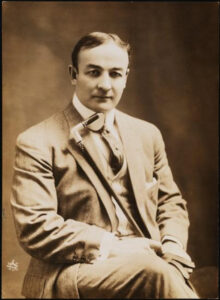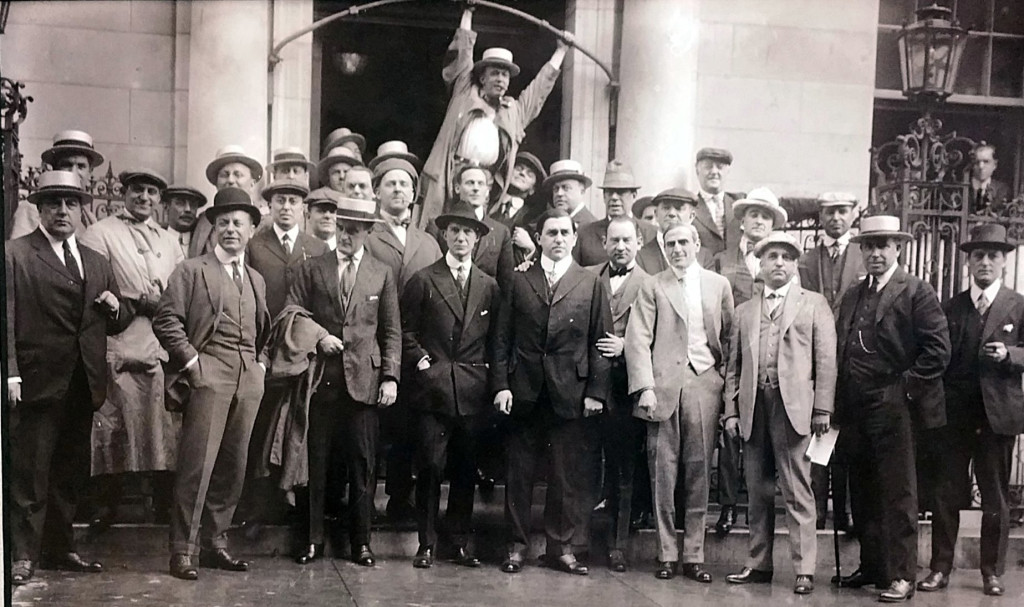William Courtleigh, Sr. (June 28, 1867-December 27, 1930) was a founding member of Actors’ Equity Association in 1913 and is credited with suggesting the name for the union. He was a stage and screen actor, elected to The Lambs in 1899, and served as Shepherd during World War I.
He was elected to The Lambs in 1899 and would go onto become the 13th Shepherd of the Club.
Courtleigh was born in Guelph, Ontario, Canada. His family emigrated to St. Louis when he was a small boy. He grew up there and attended local schools. While studying law at Washington University he joined the St. Louis based McCullough Club, an amateur dramatic organization. Courtleigh abandoned a career in law. He graduated from amateur parts to professional roles, bringing him to New York.
His acting career covered the development of melodrama from its days of buzz-saws and scenes set on railroad tracks to the more sophisticated thrillers of the 20th century. One of his greatest triumphs in New York and on tour was Blue Jeans (1890), in which the hero comes close to meeting his death strapped to a board with a buzz saw approaching. Such tricks became a staple of the 19th century melodrama and were later captured by silent movies that are on YouTube today.
During his career, Courtleigh played the juvenile leads in the New York debuts of the realistic plays by Sardou, including La Tosca, Fedora, and Cleopatra (1891). He acted in Augustin Daly’s famous repertory company at Daly’s Theatre near Broadway and 29th Street. With Daniel Frohman’s company at the Lyceum for three years, he portrayed the young Ferdinand Gadd in the New York premiere of Pinero‘s Trelaway of the “Wells” (1898). For two years he acted under Charles Frohman’s management at the Empire Theatre. In 1905 he played Little Billee in a revival of Trilby at the New Amsterdam theater with fellow Lamb Wilton Lackaye reprising his famous Svengali.
Courtleigh was a popular actor with his brother Lambs, including the playwright and thespian William Gillette (elected in 1895) who went to London and convinced Arthur Conan Doyle to let him adapt his Sherlock Holmes character into a four-act stage play. It was a smash success in 1899 in New York, giving work to scores of Lambs, including Courtleigh: he was among the first to play Doctor Watson onstage, stepping into the part in 1905.
Courtleigh succeeded the popular Joseph Grismer as Shepherd in 1913. He would serve four terms through 1917, presiding over big changes to the Club. The Lambs were swelling in numbers, as the Broadway scene exploded in popularity in the 1910s. The clubhouse, designed by Stanford White in 1905, was not large enough any longer. Rather than move again, which the Club seemed to do about every five or six years, it was decided to purchase the Hotel Woodstock property next door at 132-134 West 44th Street and build an addition, mimicking the designs of White by architect George A. Freeman. To fund this, Courtleigh and Council approved a touring Lambs’ Gambol–the fourth and final the Club would launch–in 1914 to raise funds. Construction started in early 1915. The Club took up temporary residence on the third floor of the Uptown location of Keen’s Chop House next to the Belasco Theatre.
On September 16, 1915, Courtleigh presided over 100 members at a ceremony to lay the cornerstone of the addition to the clubhouse. He helped place a copper box filled with coins, mementos, and newspapers in the foundation. Courtleigh told his brother Lambs the clubhouse was a testament to their “Mirth, revelry, and brotherly love.” A bottle of wine was smashed and the assembled Lambs sang, There’s Only One Club. It reopened December 7, 1915, with a 600-seat theater, 66 hotel rooms for Lambs to rent, a grill room, expanded bar, and library. Under Courtleigh’s watch the Club size expanded to 1,375 members by 1916.
Courtleigh’s Broadway career stretched 35 years. When the motion picture industry was launched in New York, Courtleigh was an early pioneer onscreen. Among his silent films are The Nightingale (1914), The Birth of Character (1916), Pollyanna (1919) opposite Mary Pickford; and Ashes (1922). All were filmed in New York.
Courtleigh was married twice. Courtleigh wed stage actress Helen Cross on March 17, 1890, and they had a son, William Courtleigh Jr., who also became an actor and a Lamb. Cross died in January 1908. His second wife, actress and frequent co-star–and real estate investor–Edna Conroy led to a large family. The couple moved to an estate in Rye, Westchester County.
He had five sons, one by his first wife and four by his second. William Courtleigh, Jr. (1892-1918) a Lamb who appeared on stage and screen, tragically died at age 26 during the Influenza Pandemic on March 13, 1918. The other four sons all served in World War II in the U.S. Army and Marine Corps and were feted by The Lambs. Two became actors: Stephen Courtleigh (1913-1967) sometimes acted under the stage name William Courtleigh, Jr., and Robert Courtleigh (1916-2004).
William Courtleigh, Sr., died of a case of acute indigestion on December 27, 1930, at home in Rye. He was 67. At the time of his death he was rehearsing a play, With the Tide, to try out in Wilmington, Delaware. Hundreds attended a Requiem mass for him at Saint Malachy’s Roman Catholic Church on West 49th Street. His brother Lambs served as pallbearers and The Lambs’ Quartet performed. He is interred in Woodlawn Cemetery, The Bronx, buried in the Honeysuckle section with his oldest, William, Jr. His grave is unmarked.
Written and composed by Kevin C. Fitzpatrick, Club historian/librarian, with original research from late Lambs’ historian, Lewis J. Hardee, Jr.

